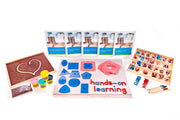Did your mom mind shout, “Homeschool science project!” as you read that? Yes, this practical life activity can also check off the homeschool science fair display box.
Worms produce “castings” which are in turn used for fertilizing plants. According to the Missouri Department of Conservation, vegetables nourished with worm castings, produced 30% larger vegetables. Results like that make for impressive charts and graphs.
In this blog post, I’ll show you how to create your own vermicomposting worm bin. You may already have a lot of the supplies on hand. This is a great way to teach your child how even the smallest organism contributes in a big way to our daily life; to be more mindful about what they are throwing out; and about recycling.
You could offer extension activities to maximize learning with your worm bin. Extensions ideas include:
Research Projects:
What Worms Eat
How Worm Composting Works
Worms Life Cycle
Different Species of Worms
Early Homeschool Math Skills:
Using your ShillerLearning number tiles, work with your child on number recognition. Set a number in front of your child and have your child make worms out of playdough. For example, if you set the number 7 in front of your child, have your child create 7 worms and place them under the number.
You can use the same approach for working with addition and subtraction as well. These extensions are perfect for students in Math Kit I.
Homeschool Language Skills:
Provide your child with a science journal to keep with their worm bin. They can write about their worm bin and record observations of what is happening. You can even offer creative writing to allow your child to use their imagination and create a story about their worms. This activity is a perfect accompaniment to Language Arts Kit B.
Complete vermicomposting bin instructions are below. I encourage you to allow your child to look for and collect the red wiggler worms needed for their bin. You can easily find red wigglers on the soil surface where the grass has been covered. If you have a flower pot that has been sitting on the grass for awhile, you will probably find red wiggler worms under it.
Allow your child to gather the dirt as well. Children love collecting materials; it feels like a treasure hunt!
To start you will need some basic items:
- Two Plastic Bins
- One lid to fit the bins
- ¼” drill bit or a screw tip
- Drill
- Shredded newspaper or junk mail (inks and other chemicals in newspapers, junk mail, and cardboard do not affect worm health)
- Dirt or compost starter
- Worms - be sure to use red wigglers
- Permanent marker, stickers, decals, or bedazzler to decorate your bin (This is not a must, but can be an enjoyable part of the project.)
What to do:
Step 1: Using your stickers or decals, decorate your bin using decals and stickers if you wish. Set this bin aside.
Step 2: Using the second plastic bin, a drill, drill bit or screw tip, drill holes at the bottom of one plastic bin. Be sure NOT to drill holes in the bin you decorated.
Step 3: Using the same plastic bin from Step 2, drill holes on the side all the way around ONLY at the top, using the same items from Step 2. You do not want your worms getting out.
Step 4: Using the drill, drill bit or screw tip and lid, drill holes in the lid.
Step 5: Put the plastic bin with the holes in it inside the bin you decorated with stickers and decals.
Step 6: Line the bottom of the plastic bin with newspaper or a paper bag.
Step 7: Add shredded newspaper. Make sure to spray water on the newspaper.
Step 8: Add dirt or compost starter. Make sure to spray water on your soil. You want it to be damp like a dampened sponge.
Step 9: Mix dirt and newspaper together.
Step 10: Add worms.
Final Step: Add veggie scraps.
Make sure you feed your worms at least once a week. And always keep their environment damp like a dampened sponge.
Make sure you feed your worms at least once a week. I recommend using raw fruit and vegetable scraps - the more vegetable material, the better. That said, avoid onions and broccoli due to their potential for odor. I also recommend avoiding meat or dairy products. Meat and dairy can attract undesirable pests and take longer to break down.
Keep the worm bin environment moist, like a dampened sponge. Don't make it too wet though, or it could attract centipedes - which may eat your composting red wigglers.
Depending on the number of worms in your bin, temperature, and materials, in as little as a few months, you'll have rich compost to feed your container or garden plants! It can be added as a soil amendment or top dressing without having to worry about burning your plants. Use it right away or store it for the next gardening season.
We’d love to see your worm bin adventures! Tag @shillerlearning on social media when you share your wiggler farmhands.
If you would like more Montessori-style homeschool inspiration, subscribe to the blog.
See Inside Our Montessori-Based Kits
This DIY project is a great way to teach your child how even the smallest organism contributes in a big way to our daily life; to be more mindful about what they are throwing out; and about recycling. Extension activities for math and language arts!






